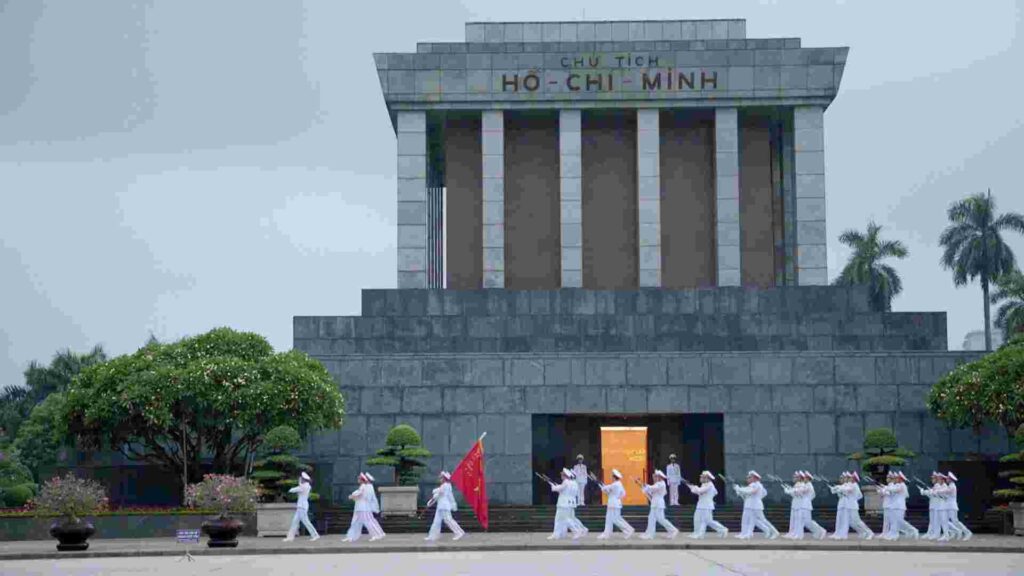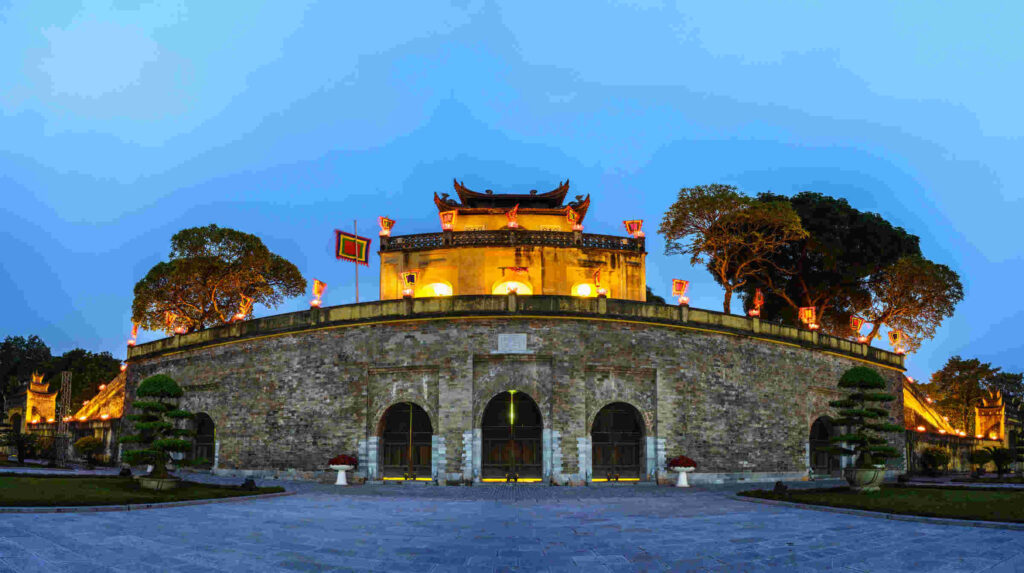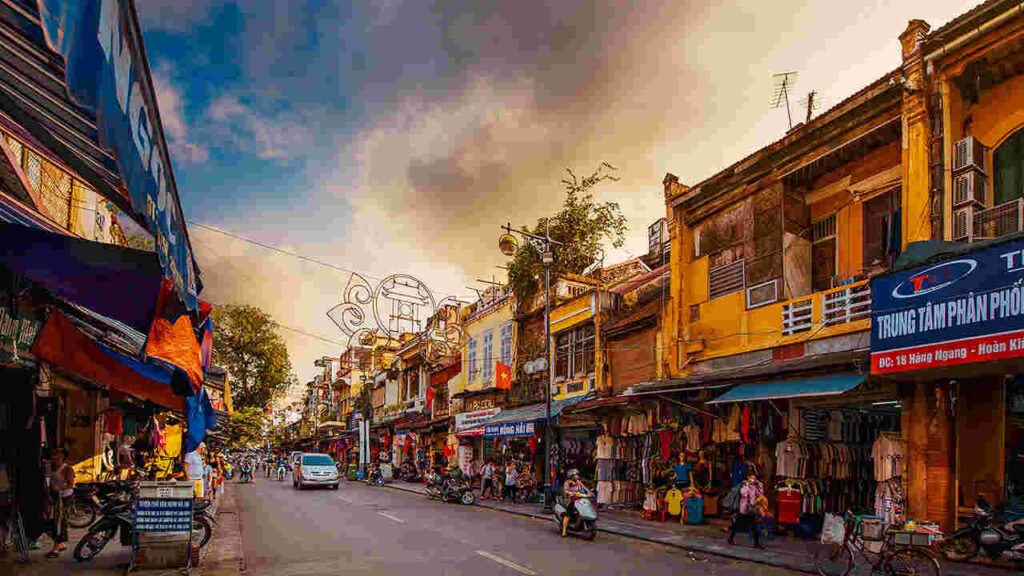Hanoi, Vietnam’s capital city, with its thousand years of history, is the economical and cultural center of Vietnam. The city has seen all the ups and downs throughout the history of the country. Having significant historical and cultural values, this city is a must-see destination for any Vietnam travel itinerary.
General introduction to Hanoi
Spanning 3,359.82 square kilometers, Hanoi is a sprawling metropolis and Vietnam’s second largest city. With a population of 8.4 million, it’s no surprise that Hanoi is also the second most densely populated city in the country. This vibrant city offers a unique blend of ancient traditions and modern urban living.
The Long History That You May Not Know
Hanoi, or Ha Noi, has a rich history that dates back over a thousand years. The city’s evolution through various dynasties is marked by significant name changes that reflect its historical importance.
Thang Long (1010-1397), Ly Dynasty
The story of Hanoi begins with Thang Long, meaning “”Ascending Dragon.”” In 1010, Emperor Ly Thai To chose this name when he moved the Imperial City to Dai La Thanh after witnessing a golden dragon soaring into the heavens. This name symbolized the city’s rise as a center of power and culture.
Dong Do (1397-1408), Ho Dynasty
Under the Ho Dynasty, the city was renamed Dong Do. During this period, the significance of the city continued to grow as it became an important political hub.
Dong Quan (1408-1428), Minh Dynasty
The name evolved again to Dong Quan, translating to “”Eastern Gateway,”” highlighting its strategic role as the eastern entrance to the country.
Dong Kinh (1428-1802), Le Dynasty
With the establishment of the Le Dynasty, Thang Long was renamed Dong Kinh to avoid confusion with the newly established province of Tay Do in Thanh Hoa.
Bac Thanh (1802-1805), Nguyen Dynasty
The Nguyen Dynasty marked another change with the name Bac Thanh meaning “”Northern Citadel,”” emphasizing Hanoi’s importance as a stronghold in northern Vietnam.
Thang Long (1805-1831), Nguyen Dynasty
In 1805, Emperor Gia Long reverted the name to Thang Long, but with a twist; “Long” now represented “prosperity” instead of its original meaning of “dragon.”
Hanoi (1831-Present)
In 1831, Hanoi finally received its present name when Emperor Minh Mang merged Thang Long with surrounding districts and provinces, solidifying its status as the capital of Vietnam.
What is the meaning of Hanoi?
The name Hanoi is believed to derive from the combination of two words: “Ha,” meaning “river” and “Noi,” meaning “inner” or “inside.” Thus, Hanoi can be interpreted as “the city located within the river,”situated on the banks of the picturesque Red River.
Top things to do in Hanoi
Hanoi is not just a city of history; it brims with activities and attractions that cater to various interests. Here are some must-visit spots:
Ho Chi Minh Mausoleum

A visit to the Ho Chi Minh Mausoleum is essential for anyone seeking to understand Vietnam’s history. This monumental structure honors the revolutionary leader Ho Chi Minh, and you can pay your respects to his embalmed body.
Imperial Academy of Vietnam

The Imperial Academy is a stunning example of ancient architecture and was once the first national university of Vietnam. Today, it serves as a museum showcasing Vietnam’s educational history.
Hoan Kiem Lake

Take a leisurely stroll around Hoan Kiem Lake, a romantic spot in the city center. The lake is surrounded by lush greenery and is home to the iconic Turtle Tower, symbolizing the city’s legends and folklore.
Ta Hien Beer Street

For a taste of local nightlife, head to Ta Hien Beer Street. This vibrant area is famous for its street-side beer stalls where locals and tourists gather to enjoy cheap beer and a lively atmosphere.
Museum Hanoi

Art lovers will appreciate the I-Museum, showcasing contemporary Vietnamese art. The museum’s innovative exhibitions make it a great place to explore modern artistic expressions.
Thang Long Imperial Citadel

Designated as a UNESCO World Heritage site, the Thang Long Imperial Citadel offers a glimpse into Vietnam’s royal past. Visitors can explore ancient architecture, archaeological sites, and beautiful gardens.
Hanoi Old Quarter

The Hanoi Old Quarter is a fascinating maze of narrow streets filled with shops, cafes, and street food stalls. Here, you can experience the daily life of locals while soaking in the city’s historical charm.
Ha Noi foods
- Vietnamese Pho
Vietnamese staple, pho is a flavorful noodle soup made with a rich broth, rice noodles, and your choice of protein (usually beef or chicken). It’s often served with fresh herbs, bean sprouts, and a squeeze of lime. - Hanoi Banh Mi
A delicious and portable sandwich made with a crispy baguette filled with a variety of meats, pate, pickled vegetables, and a dollop of mayonnaise. - Bun cha
A classic Hanoi dish consisting of grilled pork patties served with rice vermicelli, fresh herbs, and a sweet and sour dipping sauce. - Cha ca
This iconic Hanoi dish features turmeric-marinated fish fillets, grilled to perfection and served with dill, peanuts, and rice noodles. - Egg coffee
A unique Vietnamese beverage made with strong coffee, egg yolks, condensed milk, and a hint of cinnamon. The creamy texture and rich flavor make it a popular choice among locals and tourists alike. - Bun dau
A hearty dish made with tofu, pork belly, and rice noodles, served with a variety of fresh herbs and a dipping sauce. - Banh cuon
These delicate steamed rice rolls are filled with ground pork and mushrooms, and served with a savory dipping sauce. - Bun oc
A flavorful and comforting noodle soup made with snails, pork, and a variety of vegetables.
Ha Noi Weather
Hanoi experiences a tropical monsoon climate, featuring four distinct seasons throughout the year. The city’s weather plays a significant role in shaping its charm.
Seasonal Breakdown
December – March: Cool to cold, misty, and cloudy. Perfect for enjoying the city’s atmospheric charm.
- April – June: Warm to hot with clear skies, making it ideal for exploring outdoor attractions.
- June – August: Hot and humid with frequent rain showers. Be prepared for tropical downpours.
- September – November: Cool with clear skies, making it a great time for sightseeing.
Best Time to Visit
The optimal time to visit Hanoi is from April to June or September to December. April ushers in warm weather with clear skies, while September to November offers pleasant temperatures around 25 degrees Celsius, perfect for exploration. If you’re visiting in June, brace for high temperatures and humidity, with the rainy season in full swing. December can be cool and misty, so pack accordingly!
Ha Noi Transport – A Quick Guide
Common Modes of Transportation
- Motorcycles: The most popular mode of transport, providing flexibility and speed.
- Taxis and Ride-Hailing Services: Convenient for shorter distances and easy to find.
- Public Buses: An affordable option with an extensive network covering the city.
- Bicycles and Walking: Perfect for leisurely exploration, especially in the Old Quarter.
- Elevated Railway (Metro): A recent addition, providing a more efficient way to travel.
Tips for Travelers
- Crossing the Street: Proceed slowly but confidently; drivers tend to yield to pedestrians.
- Renting a Motorbike: Ensure you have a valid Vietnamese driving license or an International Driving Permit (IDP).
- Download a Map App: Google Maps or local navigation apps will help you find your way.
- Avoid Rush Hour: Traveling outside peak hours (7:00 AM to 9:00 AM and 5:00 PM to 7:00 PM) can save you from traffic jams.
Additional Tips for a Smoother Journey
- Use Ride-Hailing Apps: Grab and Be are popular and offer easy transportation options.
- Negotiate Fares: Always agree on a price before starting your taxi journey.
- Stay Aware: Keep an eye on your belongings, especially in crowded areas.
- Learn Basic Vietnamese Phrases: Knowing a few phrases can enhance your experience and interactions with locals.
Conclusion
Ha Noi city is a vibrant blend of history, culture, and culinary delights. From its storied past and stunning architecture to its bustling street life and mouthwatering dishes, this city offers a unique experience for every traveler. Whether you’re exploring ancient temples, savoring local cuisine, or simply soaking in the atmosphere, Ha Noi is a destination that promises unforgettable memories. So, pack your bags and set off on an adventure to discover the enchantment of Vietnam’s capital!







Yeah bookmaking this wasn’t a bad conclusion great post! .
I like this post, enjoyed this one thanks for putting up. “Good communication is as stimulating as black coffee and just as hard to sleep after.” by Anne Morrow Lindbergh.